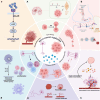Hijacking of the nervous system in cancer: mechanism and therapeutic targets
- PMID: 39915765
- PMCID: PMC11800603
- DOI: 10.1186/s12943-025-02246-5
Hijacking of the nervous system in cancer: mechanism and therapeutic targets
Abstract
The activity of neurons in the vicinity of tumors is linked to a spectrum of cellular mechanisms, including the facilitation of tumor cell proliferation, synapse formation, angiogenesis, and macrophage polarization. This review consolidates the current understanding of neuro-oncological regulation, underscoring the nuanced interplay between neurological and oncological processes (termed as Cancer-Neuroscience). First, we elucidated how the nervous system accelerates tumor growth, metastasis, and the tumor microenvironment both directly and indirectly through the action of signaling molecules. Importantly, neural activity is also implicated in modulating the efficacy of therapeutic interventions, including immunotherapy. On the contrary, the nervous system potentially has a suppressive effect on tumorigenesis, further underscoring a dual-edged role of neurons in cancer progression. Consequently, targeting specific signaling molecules within neuro-oncological regulatory pathways could potentially suppress tumor development. Future research is poised to explore the intricate mechanisms governing neuro-tumor interactions more deeply, while concurrently refining treatment strategies for tumors by targeting the crosstalk between cancer and neurons.
Keywords: Cancer; Nervous system; Neurotransmitters; Neurotrophic factors; Therapeutic implications; Tumor microenvironment.
© 2025. The Author(s).
Conflict of interest statement
Declarations. Ethics approval and consent to participate: Not applicable. Consent for publication: Not applicable. Competing interests: The authors declare no competing interests.
Figures



References
-
- Ayala G. Neuroepithelial Interactions in Cancer. Annu Rev Pathol. 2023;18:493–514. - PubMed
-
- Gregory E, Dugan R, David G, Song YH. The biology and engineered modeling strategies of cancer-nerve crosstalk. Biochim Biophys Acta Rev Cancer. 2020;1874: 188406. - PubMed
-
- Hondermarck H, Jiang CC. Time to Introduce Nerve Density in Cancer Histopathologic Assessment. Clin Cancer Res. 2023;29:2342–4. - PubMed
Publication types
MeSH terms
LinkOut - more resources
Full Text Sources
Medical

